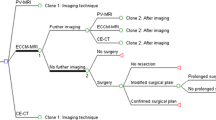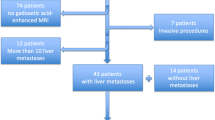Abstract
Background: Improved preoperative assessment of focal liver disease and tumors could have a potentially significant impact on their treatment. Mangafodipir trisodium (Teslascan; Nycomed Amersham Imaging, Little Chalfont, UK) is a new hepatocellular contrast agent for use with state-of-the-art MR imaging that, in early reports, is accurate in detection and characterization of liver lesions.
Methods: Records and diagnostic images of all patients undergoing enhanced Teslascan MRI (T-MRI) at our institution were reviewed. We assessed the relative sensitivities of contrast-enhanced CT scan (CECT) and T-MRI in detecting lesions, as well as the impact of T-MRI in the decision to operate or not on patients. In those patients taken to surgery, the correlation between T-MRI and intraoperative palpation and intraoperative ultrasound (IOUS) was determined.
Results: Fifty-four patients were noted on CECT to have focal liver lesions and subsequently underwent imaging with T-MRI. The T-MRI correlated with CT findings in 22 patients (41%), upstaged the liver disease in 26, and demonstrated fewer lesions in 6. Only 43 patients were considered operative candidates and T-MRI influenced the operative decision in 32 patients (74%), dissuading operative intervention in 14. In the 25 patients without clear preoperative evidence of unresectability who were taken to the operating room, T-MRI correlated with findings of intraoperative palpation in 19 (76%). In the 20 patients who underwent IOUS, T-MRI correlated with IOUS in 14 patients (70%). IOUS detected an additional nine lesions, all of which were <1 cm. Seventeen patients underwent resection and/or ablation of their liver lesions. Compared with pathology, sensitivities of CECT, T-MRI, and intraoperative evaluation were 61%, 83%, and 93%, respectively. T-MRI failed to predict hepatic-specific unresectability in only one of eight patients, the other seven having extrahepatic disease.
Conclusions: These findings suggest that T-MRI is more sensitive than CECT in the preoperative predicting of the resectability of hepatic lesions. Despite T-MRI accurately correlating with intraoperative surgical findings, IOUS should be performed on all patients prior to a final decision to resect or ablate a focal liver lesion.
Similar content being viewed by others
REFERENCES
Scheele J, Stang R, Altendorf-Hofmann A, Paul M. Resection of colorectal liver metastases. World J Surg 1995; 19: 59–71.
Fong Y, Cohen AM, Fortner JG, et al. Liver resection for colorectal metastases. J Clin Oncol 1997; 15: 938–46.
Bradley AL, Chapman WC, Wright JK, et al. Surgical experience with hepatic colorectal metastasis. Am Surg 1999; 65: 560–6.
Bismuth H, Chiche L, Castaing D. Surgical treatment of hepatocellular carcinomas in noncirrhotic liver: Experience with 68 liver resections. World J Surg 1995; 19: 35–41.
Fong Y, Sun RL, Jarnagin W, Blumgart LH. An analysis of 412 cases of hepatocellular carcinoma at a Western center. Ann Surg 1999; 229: 790–9.
Rose AT, Rose DM, Pinson CW, et al. Hepatocellular carcinoma outcomes based on indicated treatment strategy. Am Surg 1998; 64: 1128–34.
Taylor HM, Ros PR. Hepatic imaging. An overview. Radiol Clin North Am 1998; 36: 237–45.
DeMatteo RP, Fong Y. Imaging of hepatobiliary neoplasms. Surg Oncol Clin N Am 1999; 8: 59–89.
Kemmerer SR, Mortele KJ, Ros PR. CT scan of the liver. Radiol Clin North Am 1998; 36: 247–61.
Wernecke K, Rummeny E, Bongartz G, et al. Detection of hepatic masses in patients with carcinoma: Comparative sensitivities of sonography, CT, and MR imaging. AJR Am J Roentgenol 1991; 157: 731–9.
Kuszyk BS, Bluemke DA, Urban BA, et al. Portal-phase contrast-enhanced helical CT for the detection of malignant hepatic tumors: Sensitivity based on comparison with intraoperative and pathologic findings. AJR Am J Roentgenol 1996; 166: 91–5.
Soyer P, Lacheheb D, Levesque M. False-positive CT. portography: Correlation with pathologic findings. AJR Am J Roentgenol 1993; 160: 285–9.
Soyer P, Bluemke DA, Hruban RH, Sitzmann JV, Fishman EK. Primary malignant neoplasms of the liver: Detection with helical CT during arterial portography. Radiology 1994; 192: 389–92.
Soyer P, Bluemke DA, Hruban RH, Sitzmann JV, Fishman EK. Hepatic metastases from colorectal cancer: Detection and false-positive findings with helical CT during arterial portography. Radiology 1994; 193: 71–4.
Kemeny N, Huang Y, Cohen AM, et al. Hepatic arterial infusion of chemotherapy after resection of hepatic metastases from colorectal cancer. N Engl J Med 1999; 341: 2039–48.
Siegelman ES, Outwater EK. MR imaging techniques of the liver. Radiol Clin North Am 1998; 36: 263–86.
Hagspiel KD, Neidl KF, Eichenberger AC, Weder W, Marincek B. Detection of liver metastases: Comparison of superparamagnetic iron oxide-enhanced and unenhanced MR imaging at 1.5 T with dynamic CT, intraoperative US, and percutaneous US. Radiology 1995; 196: 471–8.
Seneterre E, Taourel P, Bouvier Y, et al. Detection of hepatic metastases: Ferumoxides-enhanced MR imaging versus unenhanced MR imaging and CT during arterial portography. Radiology 1996; 200: 785–92.
Hahn PF, Saini S. Liver-specific MR imaging contrast agents. Radiol Clin North Am 1998; 36: 287–97.
Fretz CJ, Stark DD, Metz CE, et al. Detection of hepatic metastases: Comparison of contrast-enhanced CT, unenhanced MR imaging, and iron oxide-enhanced MR imaging. AJR Am J Roentgenol 1990; 155: 763–70.
Ros PR, Freeny PC, Harms SE, et al. Hepatic MR imaging with ferumoxides: A multicenter clinical trial of the safety and efficacy in the detection of focal hepatic lesions. Radiology 1995; 196: 481–8.
Schultz JF, Bell JD, Goldstein RM, Kuhn JA, McCarty TM. Hepatic tumor imaging using iron oxide MRI: Comparison with computed tomography, clinical impact, and cost analysis. Ann Surg Oncol 1999; 6: 691–8.
Rofsky NM, Weinreb JC, Bernardino ME, Young SW, Lee JK, Noz ME. Hepatocellular tumors: Characterization with Mn-DPDP-enhanced MR imaging. Radiology 1993; 188: 53–9.
Murakami T, Baron RL, Federle MP, et al. Cirrhosis of the liver: MR imaging with mangafodipir trisodium (Mn-DPDP). Radiology 1996; 198: 567–72.
Murakami T, Baron RL, Peterson MS, et al. Hepatocellular carcinoma: MR imaging with mangafodipir trisodium (Mn-DPDP). Radiology 1996; 200: 69–77.
Soyer P, Levesque M, Elias D, Zeitoun G, Roche A. Detection of liver metastases from colorectal cancer: Comparison of intraoperative US and CT during arterial portography. Radiology 1992; 183: 541–4.
NiY, Marchal G, YuJ, et al. Experimental liver cancers: Mn-DPDP-enhanced rims in MR- microangiographic-histologic correlation study. Radiology 1993; 188: 45–51.
Schmidt J, Strotzer M, Fraunhofer S, Boedeker H, Zirngibl H. Intraoperative ultrasonography versus helical computed tomography and computed tomography with arterioportography in diagnosing colorectal liver metastases: Lesion-by-lesion analysis. World J Surg 2000; 24: 43–7.
Staren ED, Gambla M, Deziel DJ, et al. Intraoperative ultrasound in the management of liver neoplasms. Am Surg 1997; 63: 591–6.
Steele G Jr, Bleday R, Mayer RJ, Lindblad A, Petrelli N, Weaver D. A prospective evaluation of hepatic resection for colorectal carcinoma metastases to the liver: Gastrointestinal Tumor Study Group Protocol 6584. J Clin Oncol 1991; 9: 1105–12.
Low RN, Semelka RC, Worawattanakul S, Alzate GD, Sigeti JS. Extrahepatic abdominal imaging in patients with malignancy: Comparison of MR imaging and helical CT, with subsequent surgical correlation. Radiology 1999; 210: 625–32.
Author information
Authors and Affiliations
Corresponding author
Rights and permissions
About this article
Cite this article
Mann, G.N., Marx, H.F., Lai, L.L. et al. Clinical and Cost Effectiveness of a New Hepatocellular MRI Contrast Agent, Mangafodipir Trisodium, in the Preoperative Assessment of Liver Resectability. Ann Surg Oncol 8, 573–579 (2001). https://doi.org/10.1007/s10434-001-0573-8
Received:
Accepted:
Issue Date:
DOI: https://doi.org/10.1007/s10434-001-0573-8




